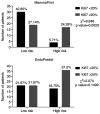Concordance between Ki-67 index in invasive breast cancer and molecular signatures: EndoPredict and MammaPrint
- PMID: 35949891
- PMCID: PMC9353786
- DOI: 10.3892/mco.2022.2565
Concordance between Ki-67 index in invasive breast cancer and molecular signatures: EndoPredict and MammaPrint
Abstract
Identifying patients with hormone receptor-positive (HR+) early invasive breast cancer (EIBC) who benefit from adjuvant chemotherapy has improved with molecular signature tests. However, due to high cost and limited availability, alternative tests are used. The present study sought to evaluate the performance of the proliferation marker Ki-67 to identify these patients and explore its association with molecular signatures and risk stratification markers. From the San José TecSalud Hospital in Monterrey México, patients with HR+ EIBC as tested with EndoPredict or MammaPrint and Ki-67 index were identified. They were categorized into two groups: Group 1 (June 2016-August 2018) was evaluated using EndoPredict and Group 2 (June 2016-August 2018) with MammaPrint. A ≥20% Ki67 index cutoff was utilized to identify highly proliferative EIBC and an area under the receiver-operating characteristic curve and κ concordance were utilized to evaluate the performance of Ki-67 index compared to molecular signature tests. In the EndoPredict group, 54/96 patients were considered high-risk based on their EPclin score, while 57/96 patients had Ki-67 index ≥20%. However, there was no significant overall concordance between them (59.37%, κ=0.168, P=0.09), while the given risk of distant recurrence given in percentage by EPclin had a positive association with the Ki67 index (P=0.04). In the MammaPrint group, 21/70 patients were considered high-risk and 36/70 patients presented with a Ki-67 index ≥20% with a significant overall concordance (67.14%, κ=0.35, P<0.001). In addition, high Ki-67 index was associated with the Nottingham histological grade in both groups. In conclusion, there was a concordance between Ki-67 and MammaPrint risk stratification of HR+ EIBC and no concordance with the EndoPredict molecular signature, but a positive association with the given percentage of recurrence and the median Ki-67 index as the cutoff at our center. Cost-effectiveness analyses of these tests in developing countries are required; until then, the use of Ki-67 appears reasonable to aid clinical decisions, together with the other established clinicopathological variables.
Keywords: EndoPredict; Ki-67; MammaPrint; early breast cancer.
Copyright: © Amezcua-Gálvez et al.
Conflict of interest statement
The authors declare that they have no competing interests.
Figures






Similar articles
-
Comparison of risk classification between EndoPredict and MammaPrint in ER-positive/HER2-negative primary invasive breast cancer.PLoS One. 2017 Sep 8;12(9):e0183452. doi: 10.1371/journal.pone.0183452. eCollection 2017. PLoS One. 2017. PMID: 28886093 Free PMC article.
-
Clinically high-risk breast cancer displays markedly discordant molecular risk predictions between the MammaPrint and EndoPredict tests.Br J Cancer. 2020 Jun;122(12):1744-1746. doi: 10.1038/s41416-020-0838-2. Epub 2020 Apr 27. Br J Cancer. 2020. PMID: 32336753 Free PMC article.
-
EndoPredict® in early hormone receptor-positive, HER2-negative breast cancer.Breast Cancer Res Treat. 2020 Jul;182(1):137-146. doi: 10.1007/s10549-020-05688-1. Epub 2020 May 20. Breast Cancer Res Treat. 2020. PMID: 32436145 Free PMC article.
-
[A Review Multigene Assays for Clinical Utility in Breast Cancer].Gan To Kagaku Ryoho. 2016 Nov;43(11):1332-1340. Gan To Kagaku Ryoho. 2016. PMID: 27899774 Review. Japanese.
-
Prognostic and Predictive Biomarkers of Endocrine Responsiveness for Estrogen Receptor Positive Breast Cancer.Adv Exp Med Biol. 2016;882:125-54. doi: 10.1007/978-3-319-22909-6_5. Adv Exp Med Biol. 2016. PMID: 26987533 Review.
Cited by
-
The Evolution of Ki-67 and Breast Carcinoma: Past Observations, Present Directions, and Future Considerations.Cancers (Basel). 2023 Jan 28;15(3):808. doi: 10.3390/cancers15030808. Cancers (Basel). 2023. PMID: 36765765 Free PMC article. Review.
-
A Novel Nomogram for Estimating a High-Risk Result in the EndoPredict® Test for Estrogen Receptor-Positive/Human Epidermal Growth Factor Receptor 2 (HER2)-Negative Breast Carcinoma.Cancers (Basel). 2025 Jan 16;17(2):273. doi: 10.3390/cancers17020273. Cancers (Basel). 2025. PMID: 39858055 Free PMC article.
-
Neoadjuvant Chemotherapy in Breast Cancer: Evaluation of the Impact on Surgical Outcomes and Prognosis.Cancers (Basel). 2024 Jun 26;16(13):2332. doi: 10.3390/cancers16132332. Cancers (Basel). 2024. PMID: 39001394 Free PMC article.
-
The usefulness of CanAssist Breast over Ki67 in breast cancer recurrence risk assessment.Cancer Med. 2023 Jun;12(12):13342-13351. doi: 10.1002/cam4.6032. Epub 2023 May 28. Cancer Med. 2023. PMID: 37245224 Free PMC article.
References
-
- Sørlie T, Perou CM, Tibshirani R, Aas T, Geisler S, Johnsen H, Hastie T, Eisen MB, van de Rijn M, Jeffrey SS, et al. Gene expression patterns of breast carcinomas distinguish tumor subclasses with clinical implications. Proc Natl Acad Sci USA. 2001;98:10869–10874. doi: 10.1073/pnas.191367098. - DOI - PMC - PubMed
-
- Goldhirsch A, Winer EP, Coates AS, Gelber RD, Piccart-Gebhart M, Thürlimann B, Senn HJ. Personalizing the treatment of women with early breast cancer: Highlights of the St Gallen International expert consensus on the primary therapy of early breast cancer 2013. Ann Oncol. 2013;24:2206–2223. doi: 10.1093/annonc/mdt303. Panel members. - DOI - PMC - PubMed
LinkOut - more resources
Full Text Sources
